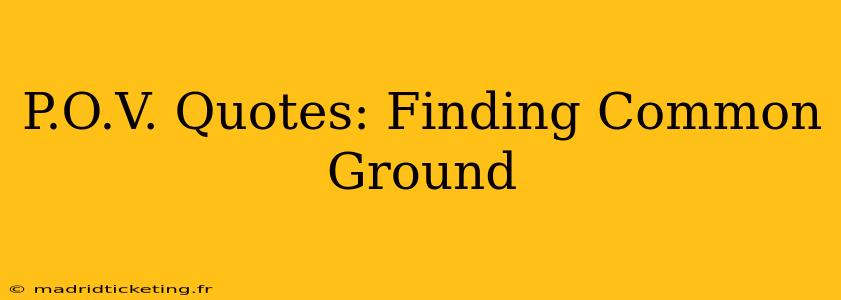Point-of-view (P.O.V.) quotes—those powerful snippets of dialogue that transport the reader directly into a character's mind—are a cornerstone of compelling storytelling. They offer a unique window into the emotional landscape of a narrative, allowing readers to connect deeply with characters and understand their motivations, fears, and desires. However, crafting effective P.O.V. quotes requires a delicate balance. They must be insightful, revealing, and seamlessly integrated into the narrative flow, avoiding jarring shifts in tone or perspective. This article delves into the art of writing impactful P.O.V. quotes, exploring techniques to find common ground between diverse perspectives and create a richer, more resonant reading experience.
What Makes a P.O.V. Quote Effective?
A truly effective P.O.V. quote transcends simple dialogue; it's a glimpse into the character's inner world. It’s less about what is said and more about how it's said and why the character says it at that precise moment. Consider these key elements:
- Revealing Subtext: The quote should hint at underlying emotions or motivations that aren't explicitly stated. What are the unspoken feelings driving the character's words?
- Consistent Voice: The language and tone should reflect the character's personality, background, and emotional state. A gruff, hardened character will speak differently than a shy, introspective one.
- Contextual Relevance: The quote must be placed within the narrative in a way that makes sense, adding to the overall story and character development. It shouldn't feel tacked on or out of place.
- Show, Don't Tell: Instead of simply stating a character's emotions, use the P.O.V. quote to show them through their words and actions.
How to Write P.O.V. Quotes Across Different Perspectives
Mastering P.O.V. quotes requires understanding how different perspectives influence language and tone. This is especially crucial when dealing with diverse characters from varied backgrounds.
Finding Common Ground: Bridging the Gaps Between Characters
Even when characters hold opposing views, P.O.V. quotes can reveal unexpected commonalities. Focus on shared experiences, underlying vulnerabilities, or universal human emotions. This creates empathy and strengthens the narrative's emotional impact.
Using P.O.V. Quotes to Develop Character Relationships
P.O.V. quotes can dramatically impact how readers perceive the relationships between characters. By showcasing contrasting viewpoints or shared understandings through internal dialogue, you can create realistic and compelling dynamics.
Common Mistakes to Avoid When Writing P.O.V. Quotes
- Overuse: Too many P.O.V. quotes can disrupt the narrative flow and feel heavy-handed. Use them sparingly and strategically.
- Inconsistent Voice: Ensure the voice and language of the P.O.V. quote are consistent with the character's established personality.
- Info-Dumping: Avoid using P.O.V. quotes to simply convey information; they should enhance the narrative, not replace it.
- Unclear Motivation: The reader should understand why the character is saying what they are saying at that particular moment.
Frequently Asked Questions (FAQ)
How can I make my P.O.V. quotes more impactful?
Focus on subtext, utilize strong verbs, and ensure the language reflects the character's unique voice and emotional state. Consider the context of the quote within the broader narrative.
What's the difference between a P.O.V. quote and regular dialogue?
A P.O.V. quote offers a direct window into the character's inner thoughts and feelings, often revealing unspoken emotions or motivations, while regular dialogue primarily focuses on the words exchanged between characters.
How can I avoid making my P.O.V. quotes feel forced or unnatural?
Practice integrating them seamlessly into the narrative flow. Use descriptive language and actions to contextualize the quote and make it feel natural and organic to the scene.
By mastering the art of crafting impactful P.O.V. quotes, writers can elevate their storytelling, forging stronger connections with their readers and creating narratives that resonate long after the final page is turned. Remember, the goal isn't just to show what a character thinks or feels, but to show how they experience the world, creating a richer and more profound reading experience.

